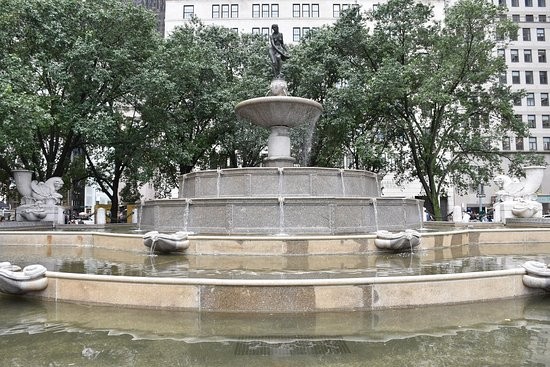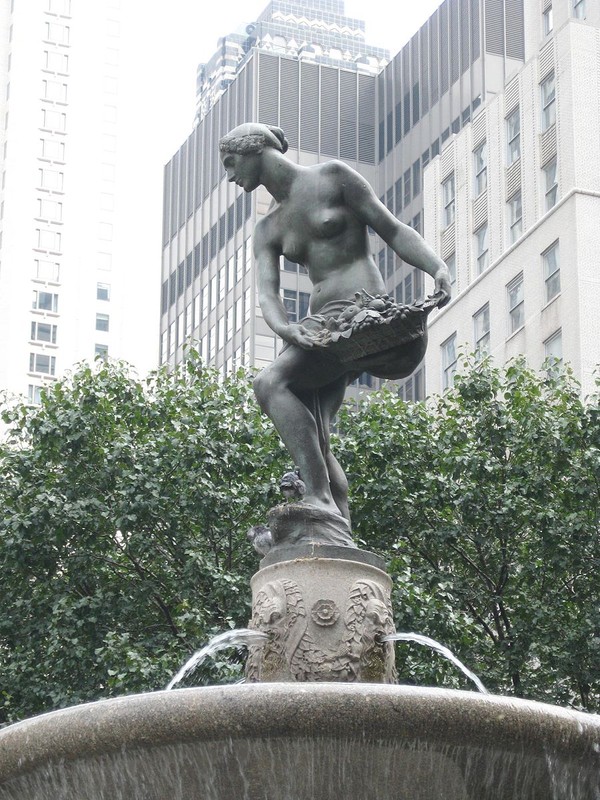Pulitzer Fountain
Introduction
Text-to-speech Audio
Images
Pulitzer Fountain in Manhattan's Grand Army Plaza

A closer look at Karl Bitter's bronze sculpture of Pomona atop the fountain

Joseph Pulitzer (1847-1911)

Backstory and Context
Text-to-speech Audio
Joseph Pulitzer was born into a prosperous family in the town of Makó in the Hungarian Empire on April 10, 1847. His father was a successful Jewish grain merchant. His mother was German and a devout Roman Catholic. When Pulitzer was a young boy, his father retired to Budapest. There, he received an education at private academies and with the help of private tutors. When he was seventeen years old, Pulitzer sought a military career and attempted to enlist in the Austrian army, the French Foreign Legion, and the British army. Despite being exceedingly tall, his poor eyesight and frail health resulted in his being rejected by all three. Soon after, however, while visiting the city of Hamburg, Pulitzer ran into a bounty broker who was recruiting for the U.S. Army. At the time, the United States was embroiled in the Civil War. Despite being able to speak only a few words in English, Pulitzer quickly sailed for the United States and enlisted in the First New York Cavalry. Also known as the Lincoln Cavalry, the unit contained many German-speaking men like Pulitzer.
Immediately after the Civil War, Pulitzer remained in the United States and settled in St. Louis, where he worked at several odd jobs while also spending a copious amount of time in libraries reading and learning English. In 1868, he caught a break and accepted a job as a reporter for the leading German-language newspaper in the city, the Westliche Post. After four years of distinguished journalism, Pulitzer purchased a controlling interest in the financially struggling newspaper in 1872, later selling it for a handsome profit. Two years later, he purchased the Staats-Zeitung, another German-language newspaper in the city, before selling its Associate Press franchise to the St. Louis Globe. By 1878, Pulitzer had purchased the St. Louis Dispatch and the St. Louis Post, and merged them to create the St. Louis Post-Dispatch. During his early years at the helm of the Post-Dispatch, the Hungarian-born newspaper editor established a national reputation as a champion of the common American through his pioneering of investigative journalism that exposed corruption in both the public and private sectors. As a result, the Post-Dispatch quickly became the city’s leading evening newspaper.
In the early 1880s, Pulitzer’s career took an unexpected turn. Failing health coupled with an 1882 incident in which his chief editorial writer murdered a political critic of the newspaper led him and his wife to travel to New York City in 1883 to embark on a relaxing European vacation. While in America’s largest urban center, however, Pulitzer met with railroad magnate Jay Gould and purchased from him the financially distressed morning newspaper, the New York World. In an effort to increase readership and turn the struggling publication around, he incorporated comic strips, illustrations, and coverage of sports and women’s fashion into its pages. Along with investigative reporting, Pulitzer also published sensationalized stories and resorted to fabricating news events. While some of these activities and changes damaged his journalistic reputation, he nevertheless transformed the World into the most-read newspaper in the United States by the end of the decade.
In the 1890s, Pulitzer and the World became involved in a fierce circulation war with William Randolph Hearst and his newspaper, the New York Journal. To increase readership as much as possible, Pulitzer deepened the publication’s commitment to fabricated stories and sensationalized journalism. The dangerous, real-world implications of the latter—coined yellow journalism—came to fruition in 1898 when the United States went to war with Spain. Pulitzer’s intensified commitment to yellow journalism in the 1890s also helped to further damage his once elevated journalistic reputation.
During the last few decades of his life, Pulitzer’s health steadily declined. By the time of his circulation war with Hearst in the 1890s, he was almost completely blind. Additionally, the nervous condition that plagued him for much of his life had worsened so much that he could barely endure noises louder than a whisper. Pulitzer died in Charleston, South Carolina in 1911. In his will, he directed the executors of his estate to endow Columbia University’s School of Journalism and allocate funds for the creation of the Pulitzer Prize.
In addition to leaving money for the establishment of the award and the journalism school, Pulitzer bequeathed $50,000 to the City of New York for the creation and installation of a fountain in what is now Grand Army Plaza. Architect Thomas Hastings of the esteemed New York architectural firm, Carrère and Hastings, won the design competition and received the commission. Dedicated in 1916, the fountain features five stepped limestone basins capped by a bronze sculpture of Pomona, the Roman goddess of abundance. Designed by sculptor Karl Bitter, she stands atop a small circular basin holding a basket of fruit.
Sources
"Joseph Pulitzer." Encyclopædia Britannica. Web. 11 February 2021 <https://www.britannica.com/biography/Joseph-Pulitzer>.
"Pulitzer Fountain." Central Park Conservancy. Web. 11 February 2021 <https://www.centralparknyc.org/locations/pulitzer-fountain>.
"Pulitzer Fountain." New York City Department of Parks and Recreation. The City of New York. Web. 11 February 2021 <https://www.nycgovparks.org/parks/grand-army-plaza-m062/monuments/1291>.
Tucker, Spencer C., ed. The Encyclopedia of the Spanish-American and Philippine American War: A Political, Social, and Military History. Vol. I, A-L. Santa Barbara, CA: ABC-CLIO, 2009.
https://www.tripadvisor.co.nz/ShowUserReviews-g60763-d14082732-r579379841-Pulitzer_Fountain-New_York_City_New_York.html
https://livingnewdeal.org/projects/grand-army-plaza-pomona-statue-restoration-new-york-ny/
https://en.wikipedia.org/wiki/Joseph_Pulitzer
